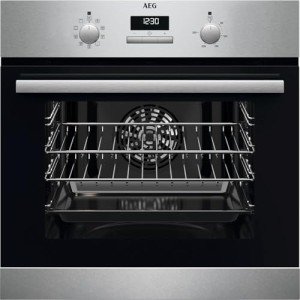You'll Never Guess This Single Fan Oven's Secrets
Understanding Single Fan Ovens: A Comprehensive Guide
Introduction
As modern-day kitchen areas grow significantly sophisticated, appliances created for performance and performance are at the forefront of consumer interest. One such device that remains popular among home cooks and baking enthusiasts is the single fan oven, an electric design understood for its flexibility and ease of usage. This article provides extensive information about single fan ovens, including their performance, benefits, types, and considerations for purchase.
What is a Single Fan Oven?
A single fan oven, also referred to as a stove, features a single cooking chamber with a fan and exhaust system that flows hot air uniformly throughout the cooking area. This leads to an even cooking temperature level and boosted cooking efficiency compared to conventional static ovens.
Secret Components of a Single Fan Oven
- Heating Elements: Usually situated on top and bottom, these generate heat for cooking.
- Fan: The main feature that distributes the hot air within the oven, promoting quicker and more even cooking.
- Thermostat: Regulates the temperature to make sure ideal cooking conditions.
- Control board: Provides user interface alternatives for setting temperature levels, cooking times, and modes.
How Does a Single Fan Oven Work?
Single fan ovens operate by combining the heat from the heating components with the air motion produced by the fan. The hot air is dispersed uniformly around the food, significantly minimizing cooking time while also permitting lower cooking temperatures.
Benefits of Using a Single Fan Oven
- Faster Cooking Times: The flowing air permits food to prepare faster compared to conventional ovens.
- Even Cooking: Food is exposed to constant heat from all sides, reducing the chances of unequal cooking or locations.
- Flexibility: These ovens can be utilized for baking, roasting, and even barbecuing, making them appropriate for a wide range of dishes.
- Energy Efficiency: By cooking at lower temperatures and in less time, these ovens may use less energy than their traditional equivalents.
- Moisture Retention: The style helps keep wetness in dishes, resulting in juicy roasts and baked products with a light texture.
Kinds Of Single Fan Ovens
When thinking about a single fan oven, consumers might encounter various types based on features and design. Here are a couple of typical types:
1. Built-in Single Fan Ovens
- Description: Integrated into kitchen cabinetry for a seamless appearance.
- Pros: Saves counter area, aesthetically pleasing.
- Cons: Higher setup costs, might need expert help.
2. Freestanding Single Fan Ovens
- Description: Standalone units that can be placed anywhere in the kitchen.
- Pros: Easy to install, flexible placement.
- Cons: Can use up more area, might not blend well with kitchen cabinetry.
3. Range Cookers with Fan Ovens
- Description: Multiple cooking options, including a fan oven, combined in one system.
- Pros: Offers various cooking methods, suitable for enthusiastic cooks.
- Cons: Generally more expensive, bigger footprint.
Contrast Table of Single Fan Oven Types
| Type | Pros | Cons |
|---|
| Built-in | Space-saving, aesthetically pleasing | Greater expenses, professional setup needed |
| Freestanding | Versatile placement | Takes up more space, may not match cabinets |
| Range Cooker | Multiple cooking techniques | Greater price, bigger size |
Choosing the Right Single Fan Oven
When choosing on a single fan oven, numerous aspects need to be thought about to guarantee that it fulfills individual cooking needs and fits within your kitchen design.
Elements to Consider
- Size and Capacity: The size needs to complement your kitchen layout while using enough capacity for your cooking practices.
- Features and Functions: Look for adjustable racks, self-cleaning options, and multiple cooking modes to boost versatility.
- Energy Efficiency: Check for energy ratings; some models are developed to be especially energy-efficient.
- Budget plan: Costs can differ significantly, making it vital to develop a reasonable budget beforehand.
Upkeep Tips for Single Fan Ovens
- Routine Cleaning: Wipe down interior surface areas after usage to prevent residue accumulation.
- Examine the Fan: Ensure the fan is complimentary from obstructions and functioning correctly.
- Examine Seals: Regularly examine the door seals for wear and tear to maintain cooking effectiveness.
- Expert Servicing: Schedule routine expert checks to make sure optimal operation.
Frequently Asked Questions about Single Fan Ovens
1. Can I utilize my single fan oven for baking?
Definitely! Single fan ovens are outstanding for baking, providing constant temperature levels important for cakes, cookies, and breads.
2. Is it required to pre-heat a single fan oven?
While preheating is usually advised for ideal results, due to the effectiveness of a fan oven, some dishes may not need it.
3. Can I prepare several dishes simultaneously?
Yes! The even heat distribution in single fan ovens enables you to bake or roast multiple dishes at the same time, utilizing all rack levels efficiently.
4. Does a single fan oven cook faster than a traditional oven?
Yes, the fan-assisted heating lowers cooking times, making it possible for much faster food preparation.

Single fan ovens use an extraordinary balance of speed, adaptability, and efficiency, making them an important addition to any kitchen. Whether for baking, roasting, or everyday cooking, these ovens make sure that home cooks can produce scrumptious meals with ease. By comprehending the benefits, types, and considerations for buying a single fan oven, consumers can make an educated decision that aligns with their cooking desires and kitchen characteristics.
Embracing the performances of a single fan oven certainly paves the way for boosted cooking experiences in the modern kitchen.


